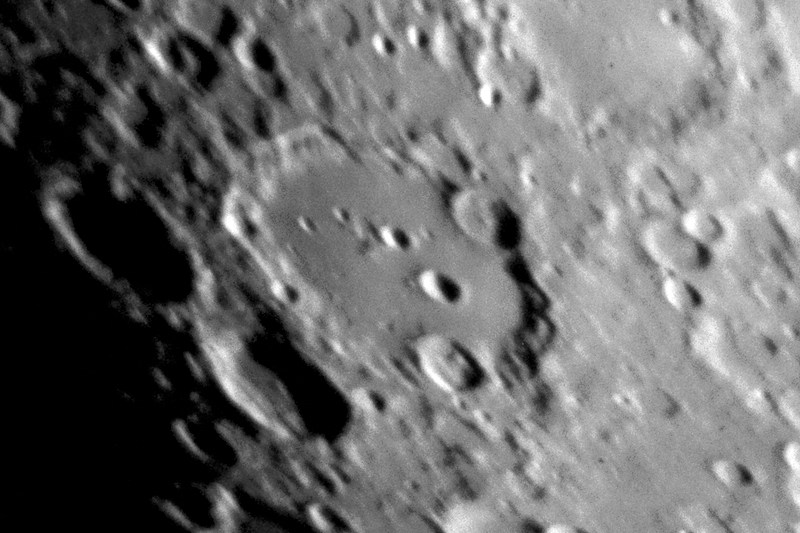
ETX-90RA & 8" LX200-ACF Lunar Observing & Imaging
Posted: 25 October 2012
Opened the observatory Wednesday, 24 October 2012, at 1748 MST, 78°F, to clear skies. There was an occasional strong breeze and there was a slight haze visible around the waxing gibbous moon high in the southeastern sky. I set up my Meade ETX-90RA on the observatory patio:

At 1813 MST, I began using the ETX-90RA for lunar observing. I used a 26mm eyepiece (48X) and 26mm + 2X Barlow Lens (96X). Seeing was not very good. After doing some initial observing, I attached the iPhone 4 on the ETX-90RA using the MX-1 afocal adapter. I used the iPhone earbuds/mic cord as a remote shutter release to avoid inducing any vibrations from touching the iPhone to take the exposure. This is 48X with some digital zoom applied on the iPhone and a slight crop during post-processing:

I then took a series of iPhone photos along the terminator using 96X and no digital zoom (but some cropping during post-processing):



I then did some more lunar observing with the ETX-90RA using the 26mm + 2X Barlow Lens (96X), 9.7mm eyepiece (129X), and 5.5mm eyepiece (227X). The breezes had died down by this time but seeing was still not very good. However, the view with the 5.5mm eyepiece was very good at times even though it exceeded the theoretical maximum magnification (180X) for the ETX-90. I decided to take a handheld iPhone afocal photograph through the 5.5mm eyepiece of the crater Clavius and surrounding area:

I also did a video of Clavius with the iPhone for stacking. The poor seeing, combined with handholding the phone, wasn't good enough for stacking the video but one frame did have a nice steady view:

I ended ETX use at 1900 MST and powered up the Meade 8" LX200-ACF. I began lunar observing with the 8" at 1903 MST using 26mm (77X), 9.7mm (206X), and 5.5mm (364X) eyepieces. The views through the 8" were very nice. I tried pushing the magnification to 727X (exceeding the 400X theoretical maximum magnification for an 8" telescope) but the poor seeing did not provide a good view. However, the view at 412X (9.7mm eyepiece + 2X Barlow Lens) was pretty good during moments of steady seeing. I switched from the star diagonal to the visual back and mounted the D7000 DSLR at prime focus for lunar imaging. The moon at prime focus just fit in the camera FOV, as seen in this full-frame, 1/400sec, ISO 400, image:

This next photo is the crater Clavius with the D7000 DSLR using eyepiece projection (9mm eyepiece, 222X), cropped from the full-frame image:

I then did some D7000 DSLR HD video recording of the crater Clavius and the crater Copernicus at 222X, 1/250sec, and ISO 3200 and ISO 6400, respectively. The poor seeing resulted in a less than ideal stacking of 772 frames of Clavius:

But one frame of the HD video of Clavius was pretty good:

The 641 frame image stacking of the Copernicus was also impacted by the poor seeing:

But again, one video frame was pretty good:

I ended lunar imaging at 1939 MST. I switched to the star diagonal and did some more lunar observing at 364X.
Closed the observatory at 1957 MST, 59°F.
I will be attending the Arizona Science & Astronomy Expo, 10-11 November 2012. When I'm not attending one of the scheduled events, you can probably find me at one of these booths:
SkyShed POD
OPT
Meade
Lunt Solar Systems
Astronomy Technology Today
I'll probably be wearing a SkyShed POD cap and a Mighty ETX Site T-shirt.
Comments are welcome; use the Comments section below, or you can Email Me. Thanks.
Go to the previous report.
Return to the Cassiopeia Observatory Welcome Page.